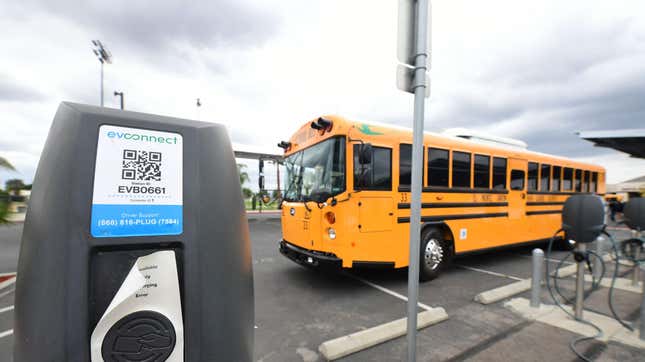
The Biden Administration wants to make that plume of noxious smoke sputtering out of your neighborhood school bus’ exhaust a thing of the past, and it’s ready to pump out some cash to do so.
In a fact sheet released Monday, Vice President Kamala Harris revealed federal plans to dish out billions in funds—scoured mostly from the 2021 Bipartisan Infrastructure package—to reduce emissions from buses and a bevy of other hefty polluting vehicles currently underpinning U.S. public transit.
For school buses, the administration says it plans to award $17 million in funds to the Environmental Protection Agency to fund zero-emission and low-emissions school buses. Another $7 million pulled from the American Rescue Plan will go towards replacing old diesel school buses with newer electric versions. The administration will also use $10 million in funds from the Diesel Emissions Reduction Act to replace diesel school buses with “cleaner,” though not necessarily electric, alternatives.
“Our transportation sector has reached a turning point,” Harris said during a press conference. “These grants will make public transit more reliable and more affordable which means shorter waits and more reliable commutes for folks who need to take public transit to get where they need to go.” The Vice President also said this investments will create good jobs.
Harris was joined on stage by a Washington D.C.-based bus driver who claimed he had driven newer electric buses and noticed improvements for both himself and passengers.
“Electric buses are more fuel-efficient, better for the environment, and more comfortable,” the driver said. “I’ve also heard feedback from passengers that electric buses don’t trigger their asthma symptoms nearly as much.”
The much larger chunk of funds, (around $1.1 billion for 2022) will go toward a Department of Transportation program aimed at providing public transit agencies and states with funds to purchase or lease lower emission public transit buses across the country. Once again, though these buses may reduce emissions compared to the status quo guzzlers, they’re not necessarily all-electric. According to the administration, those new busses will be built and manufactured in the U.S. Meanwhile, around 5% of the grants awarded in this new program will reportedly go towards training workforces to learn how to actually use and maintain these new vehicles.
In addition to all those funds, Harris said a new set of strict emissions standards currently being finalized by the EPA could also help nudge public transit in a cleaner direction. If approved, those new rules would set stronger greenhouse gas emissions standards for buses and other heavy-duty vehicles which reportedly make up nearly one-quarter of all greenhouse gasses attributed to U.S. transportation. That’s potentially significant, considering EPA estimates show transportation accounts for more (29%) greenhouse gas emissions than any other sector. All told, the administration claims a full shift towards zero emissions in the nation’s heavy-duty fleet could prevent 2,000 deaths per year and eliminate 18,000 cases of asthma.
“These grants will help build a better America by sending a signal to industry and communities that low and zero-emissions vehicles are the future,” EPA Administrator Michael Regan said during the press conference.

If successful, a shift away from gas-burning school buses and other heavy-duty trucks in the public sector would go a long way towards achieving the Biden administration’s goal of having all federal agencies purchase 100% zero-emission vehicles for the federal fleet by 2035. Stack that on top of the administration’s other goal of ensuring at least half of all new cars sold in the U.S. are electric by 2030 and you could start to see some real, meaningful progress on emissions reductions.
Of course, here’s where we get to the “but.” Though allocating funds and setting timelines are important, they don’t necessarily guarantee any individual agency or state will actually approach electrification with the same enthusiasm as the federal government. That became clear this year with the U.S. Postal Service, which choose to replace the overwhelming majority of its aging postal truck fleet with shitty, gas-guzzling clunkers instead of available electric alternatives. The USPS’ final 90/10 gas to electric vehicle split came despite desperate pleas from the EPA and pro-EV lawmakers.
Still, Harris, Reagan, and other regulators cheerleading the program on Monday said they felt optimistic and celebrated what they see as history in real-time.
“Folks, this is a historic moment for the transportation sector.,” Regan said “[These proposals] are just the first steps on the route to a zero-emissions future.”
And hey, given the U.S.’ long history of simply ignoring climate proposals outright, getting the ball moving might just warrant breaking out a few champagne glasses.